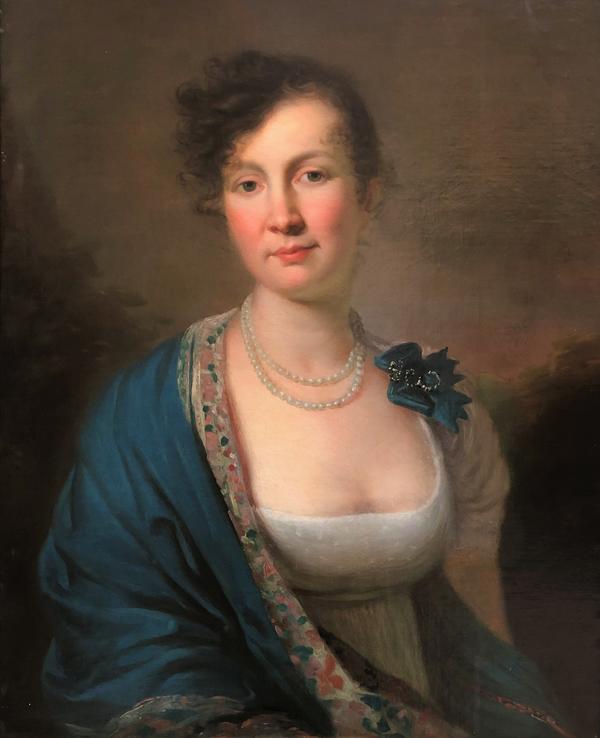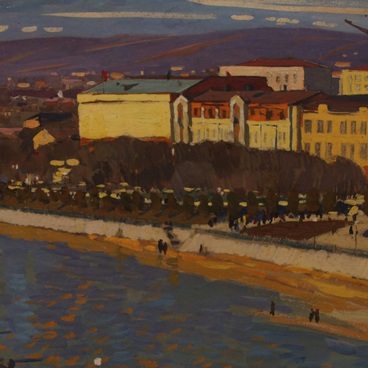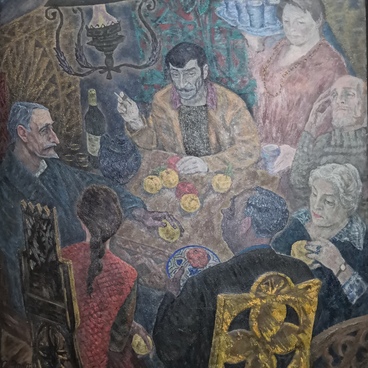The Portrait of Countess Zubova is attributed to the brush of Alois Molinari. Presumably, the artist created the portrait in the 1800-s. He worked in the oil-on-canvas technique.
The artist depicted the daughter of Generalissimo Alexander Suvorov, after marriage known as Countess Natalia Zubova. He painted a half-length image against an ochre-brown background. The woman wears a white dress with a deep oval neckline. A blue shawl drapes her shoulders, and a blue ribbon brooch adorns her right shoulder. Her high forehead is framed by light-brown hair, combed to the left. Although the artist idealized his model, he managed to convey Natalia Zubova’s countenance and true character. In the picture, she appears a calm and good-natured woman.
Natalia Alexandrovna was the only daughter of great military commander Alexander Suvorov. Her father affectionately called her Suvorochka. At the age of five, the father placed his daughter into the care of the Smolny Institute, where she was called “a kind and virtuous little thing”. Spending a lot of time away from home, her father rarely had a chance to see his daughter, but they kept up a lively and warm correspondence.
The fame of Alexander Suvorov made his daughter a very eligible bride for many grooms. The Empress Catherine II participated in her fate. At that period the Empress extended favours to Platon Zubov.
She intended to strengthen the position of the Zubov clan and proposed to marry the girl to Count Nikolai Zubov. The marriage did take place, but turned out badly. Natalya Alexandrovna was a gentle and loving wife, while her husband was a rude man and was at odds with his father-in-law.
In 1800, Alexander Suvorov left this world. A year later, the Countess’ husband, Nikolai Zubov, took part in the assassination of Emperor Paul I. These upheavals drastically changed the life of Natalia Alexandrovna. She came to Moscow and for some time lived separately from her husband. In 1805, Nikolai Zubov died. A widow at the age of thirty, Natalia Alexandrovna devoted herself to the upbringing of six children.
The artist depicted the daughter of Generalissimo Alexander Suvorov, after marriage known as Countess Natalia Zubova. He painted a half-length image against an ochre-brown background. The woman wears a white dress with a deep oval neckline. A blue shawl drapes her shoulders, and a blue ribbon brooch adorns her right shoulder. Her high forehead is framed by light-brown hair, combed to the left. Although the artist idealized his model, he managed to convey Natalia Zubova’s countenance and true character. In the picture, she appears a calm and good-natured woman.
Natalia Alexandrovna was the only daughter of great military commander Alexander Suvorov. Her father affectionately called her Suvorochka. At the age of five, the father placed his daughter into the care of the Smolny Institute, where she was called “a kind and virtuous little thing”. Spending a lot of time away from home, her father rarely had a chance to see his daughter, but they kept up a lively and warm correspondence.
The fame of Alexander Suvorov made his daughter a very eligible bride for many grooms. The Empress Catherine II participated in her fate. At that period the Empress extended favours to Platon Zubov.
She intended to strengthen the position of the Zubov clan and proposed to marry the girl to Count Nikolai Zubov. The marriage did take place, but turned out badly. Natalya Alexandrovna was a gentle and loving wife, while her husband was a rude man and was at odds with his father-in-law.
In 1800, Alexander Suvorov left this world. A year later, the Countess’ husband, Nikolai Zubov, took part in the assassination of Emperor Paul I. These upheavals drastically changed the life of Natalia Alexandrovna. She came to Moscow and for some time lived separately from her husband. In 1805, Nikolai Zubov died. A widow at the age of thirty, Natalia Alexandrovna devoted herself to the upbringing of six children.



